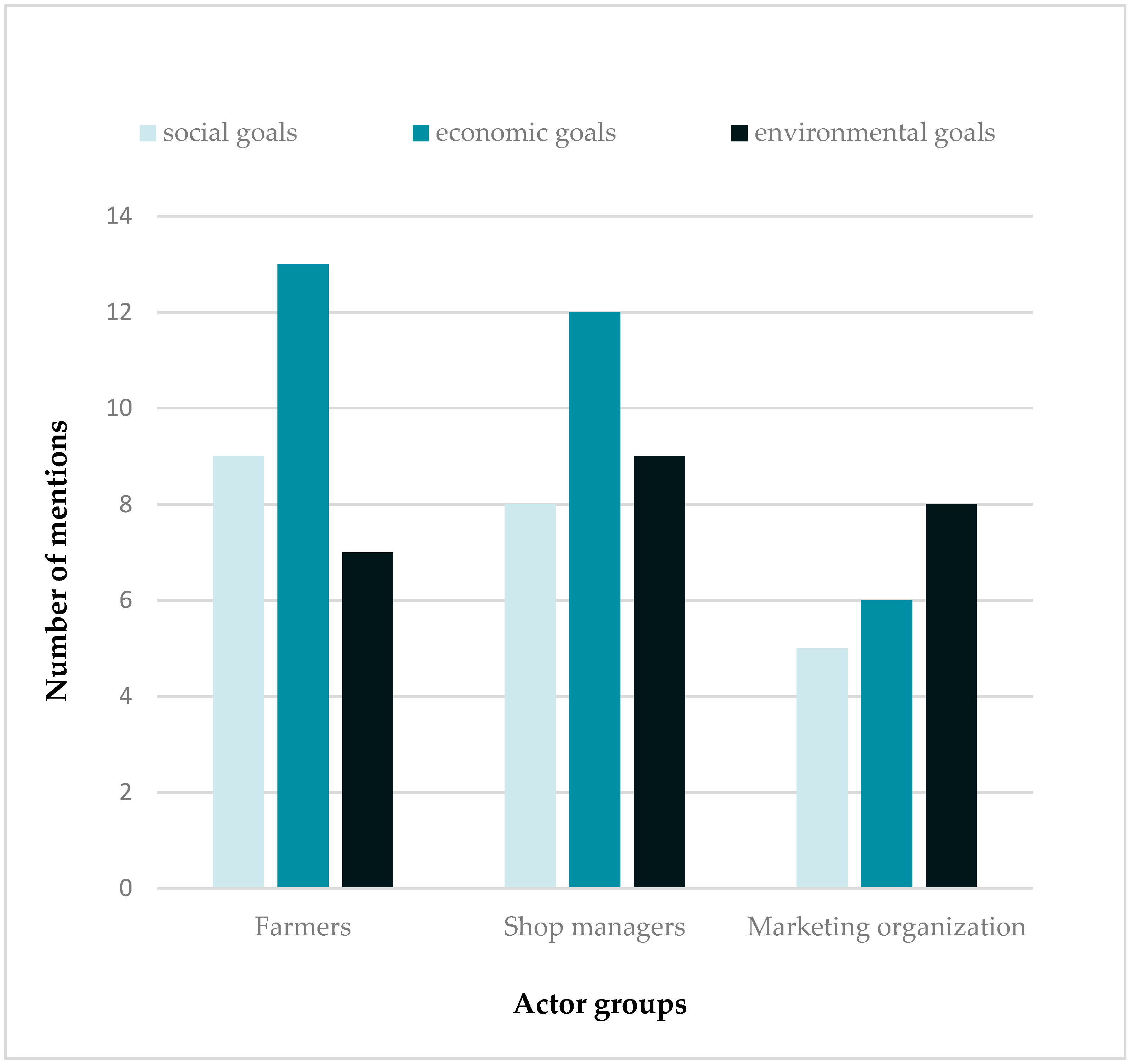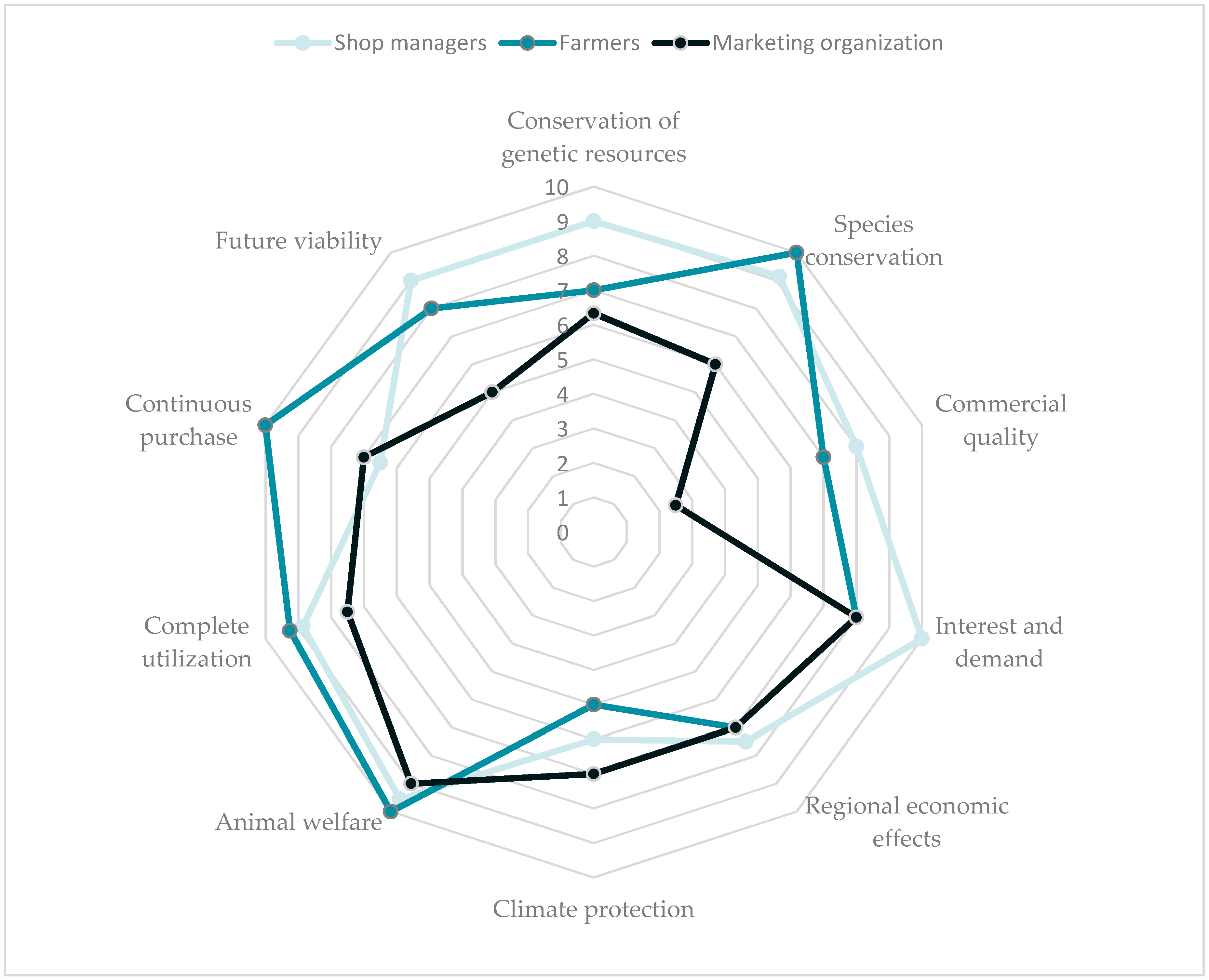Integrating Sustainability Goals in Innovation Processes: Applying a Decision Support Tool in a Dual-Purpose Chicken Case Study
Abstract
1. Introduction
- To test whether the tool was suitable for improving communication between actors along the value chain, as well as marketing sustainability to consumers;
- To explore whether the tool could help the coordinating actors identify fields of action for steering and adjusting the value chain.
2. Materials and Methods
2.1. Case Study: Dual-Purpose Chicken Production and Marketing in Germany
2.2. Tool Design
- Select goals: From an initial selection and range of 47 goals, the interviewees were asked to select seven sustainability goals that were considered most important for the added value of the initiative. The interviewees were also able to add further goals or to comment on and discuss the goal set;
- Rate goals: The selected goals were rated on a scale from one to ten, indicating to what degree they were considered to be already implemented (1 = not implemented at all, 10 = fully implemented);
- Compare groups: The goal selection and rating were directly visualized in spider diagrams.
2.3. Tool Application
2.4. Data Analysis
3. Results
3.1. Absolute Frequency of the Selected Sustainability Goals
3.2. Perceived Implementation of the Selected Sustainability Goals
3.3. Goals According to the Sustainability Dimension and Actor Group
3.4. Common Sustainability Goals of All Groups
3.5. Common Sustainability Goals Between Two Actor Groups of the Value Chain
3.6. Detailed Perception of the Sustainability Goals
4. Discussion
4.1. Communication and Marketing
4.2. Improvements to the Value Chain Regarding Sustainability
4.3. Broader Context
4.4. Discussion of the Shortcomings of the Tool and Its Application
5. Conclusions
Author Contributions
Funding
Acknowledgments
Conflicts of Interest
Appendix A
| Sustainability Goal | Sustainability Dimension | Absolute Number of Mentions | Average Degree of Perceived Implementation |
|---|---|---|---|
| Animal welfare | environmental | 15 | 9.5 |
| Complete utilization | environmental | 13 | 8.8 |
| Species conservation | environmental | 10 | 8.6 |
| Future viability | social | 9 | 6.7 |
| Conservation of genetic resources | environmental | 7 | 7.6 |
| Closed ecological cycle | environmental | 7 | 8.4 |
| Regional economic effects | economic | 6 | 7.3 |
| Commercial quality | economic | 5 | 5.6 |
| Operating efficiency | economic | 4 | 5 |
| Involvement of local actors | social | 4 | 8.3 |
| Solidarity with the farmer | social | 4 | 6.3 |
| Sovereignty of farmers | environmental, social | 4 | 5.3 |
| Implementation of alternative approaches | economic | 4 | 8.5 |
| Independence | social | 4 | 6 |
| Continuous purchase | economic | 4 | 7.5 |
| Consumer acceptance | economic | 3 | 4.3 |
| Diversification of the farm structure | economic | 3 | 7.7 |
| Interest and demand | economic | 3 | 8.7 |
| Competitiveness | economic | 3 | 4.3 |
| Climate protection | environmental | 3 | 6 |
| Condition of soil, water balance and climate | environmental | 3 | 7.3 |
| Willingness to pay a premium | economic | 2 | 7.5 |
| Exchange between actors | social | 2 | 7.5 |
| Durability | environmental, social | 2 | 5.5 |
| Taste/aesthetics | social | 2 | 5.5 |
| Consensus among actors | social | 2 | 8 |
| Economic circle | economic | 2 | 5.5 |
| Personal fulfillment | economic | 2 | 5 |
| Additional jobs | social | 2 | 7.5 |
| Revaluation | economic | 1 | 8 |
| Diversification of production | economic | 1 | 8 |
| Efficient management | economic | 1 | 4 |
| Habitat conservation | environmental | 1 | 5 |
| Cost coverage | economic | 1 | 3 |
| Additional income opportunity | social | 1 | 2 |
| Hedging | social | 0 | - |
| Diversification personnel structure | social | 0 | - |
| Introduction of improvements | economic | 0 | - |
| Use of local resources | environmental | 0 | - |
| Fusion of activities | social | 0 | - |
| Joint activities | social | 0 | - |
| Financial surplus | economic | 0 | - |
| Horizontal expansion | economic | 0 | - |
| Resource sufficiency | environmental | 0 | - |
| Vertical expansion | economic | 0 | - |
| Financial provision | social | 0 | - |
| Product condition/ durability | economic | 0 | - |
References
- van den Heiligenberg, H.A.R.M.; Heimeriks, G.J.; Hekkert, M.P.; van Oort, F.G. A habitat for sustainability experiments: Success factors for innovations in their local and regional contexts. J. Clean. Prod. 2017, 169, 204–215. [Google Scholar] [CrossRef]
- Reed, M.S.; Fraser, E.D.G.; Dougill, A.J. An adaptive learning process for developing and applying sustainability indicators with local communities. Ecol. Econ. 2006, 59, 406–418. [Google Scholar] [CrossRef]
- Blok, V.; Gremmen, B.; Wesselink, R. Dealing with the Wicked Problem of Sustainability in advance: The Role of Individual Virtuous Competence. Bus. Prof. Ethics J. 2016, 34, 297–327. [Google Scholar] [CrossRef]
- Geels, F.W.; Schot, J. Typology of sociotechnical transition pathways. Res. Policy 2007, 36, 399–417. [Google Scholar] [CrossRef]
- Klerkx, L.; Aarts, N.; Leeuwis, C. Adaptive management in agricultural innovation systems: The interactions between innovation networks and their environment. Agric. Syst. 2010, 103, 390–400. [Google Scholar] [CrossRef]
- Orenstein, D.E.; Shach-Pinsley, D. A Comparative Framework for Assessing Sustainability Initiatives at the Regional Scale. World Dev. 2017, 98, 245–256. [Google Scholar] [CrossRef]
- Hatt, S.; Artru, S.; Brédart, D.; Lassois, L.; Francis, F.; Haubruge, É.; Garré, S.; Stassart, P.M.; Dufrêne, M.; Monty, A.; et al. Towards sustainable food systems: The concept of agroecology and how it questions current research practices. A review. Biotechnol. Agron. Soc. Environ. 2016, 20, 215–224. [Google Scholar]
- Berthet, E.T.; Hickey, G.M. Organizing collective innovation in support of sustainable agro-ecosystems: The role of network management. Agric. Syst. 2018, 165, 44–54. [Google Scholar] [CrossRef]
- Sonoda, Y.; Oishi, K.; Chomei, Y.; Hirooka, H. How do human values influence the beef preferences of consumer segments regarding animal welfare and environmentally friendly production? Meat Sci. 2018, 146, 75–86. [Google Scholar] [CrossRef] [PubMed]
- Vecchio, R. European and United States farmers’ markets: Similarities, differences and potential developments. In Proceedings of the A Resilient European Food Industry and Food Chain in a Challenging World, Chania, Crete, Greece, 3–6 September 2009. [Google Scholar]
- Grunert, K.G.; Sonntag, W.I.; Glanz-Chanos, V.; Forum, S. Consumer interest in environmental impact, safety, health and animal welfare aspects of modern pig production: Results of a cross-national choice experiment. Meat Sci. 2018, 137, 123–129. [Google Scholar] [CrossRef] [PubMed]
- Hörisch, J. How business actors can contribute to sustainability transitions: A case study on the ongoing animal welfare transition in the German egg industry. J. Clean. Prod. 2018, 201, 1155–1165. [Google Scholar] [CrossRef]
- Ortega, D.L.; Wolf, C.A. Demand for farm animal welfare and producer implications: Results from a field experiment in Michigan. Food Policy 2018, 74, 74–81. [Google Scholar] [CrossRef]
- Spoelstra, S.F.; Groot Koerkamp, P.W.G.; Bos, A.P.; Elzen, B.; Leenstra, F.R. Innovation for sustainable egg production: Realigning production with societal demands in The Netherlands. Worlds Poult. Sci. J. 2013, 69, 279–298. [Google Scholar] [CrossRef]
- Willer, H.; Schaack, D.; Lernoud, J. Organic Farming and Market Development in Europe and the European Union. In The World of Organic Agriculture: Statistics and Emerging Trends 2019; Willer, H., Lernoud, J., Eds.; FiBL: Frick, Switzerland; IFOAM: Bonn, Germany, 2019; ISBN 978-3-03736-119-1. [Google Scholar]
- European Commission. Special Eurobarometer 229/Wave 63.2—TNS Opinion & Social: Attitudes of Consumers towards the Welfare of Farmed Animals; European Commission: Brussels, Belgium, 2005. [Google Scholar]
- Karcher, D.M.; Mench, J.A. Overview of commercial poultry production systems and their main welfare challenges. In Advances in Poultry Welfare; Elsevier: Amsterdam, The Netherlands, 2018; pp. 3–25. ISBN 978-0-08-100915-4. [Google Scholar]
- Leenstra, F.; Munnichs, G.; Beekman, V.; van den Heuvel-Vromans, E.; Aramyan, L.; Woelders, H. Killing day-old chicks? Public opinion regarding potential alternatives. Anim. Welf. 2011, 20, 37–45. [Google Scholar]
- Brümmer, N.; Christoph-Schulz, I.; Rovers, A.-K. Consumers’ Perspective on Dual-purpose Chickens as Alternative to the Killing of Day-old Chicks. Int. J. Food Syst. Dyn. 2018, 9, 390–398. [Google Scholar]
- Gremmen, B.; Bruijnis, M.R.N.; Blok, V.; Stassen, E.N. A Public Survey on Handling Male Chicks in the Dutch Egg Sector. J. Agric. Environ. Ethics 2018, 31, 93–107. [Google Scholar] [CrossRef]
- Krautwald-Junghanns, M.-E.; Cramer, K.; Fischer, B.; Förster, A.; Galli, R.; Kremer, F.; Mapesa, E.U.; Meissner, S.; Preisinger, R.; Preusse, G.; et al. Current approaches to avoid the culling of day-old male chicks in the layer industry, with special reference to spectroscopic methods. Poult. Sci. 2018, 97, 749–757. [Google Scholar] [CrossRef]
- Verbeke, W. Stakeholder, citizen and consumer interests in farm animal welfare. Anim. Welf. 2009, 18, 325–333. [Google Scholar]
- Diehl, K. Sustainability assessment of agro-ecological innovations at territorial and value chain scale. In Proceedings of the 12th European IFSA Symposium on Social and Technological Transformation of Farming Systems: Diverging and Converging Pathways, Newport, UK, 12–15 January 2016. [Google Scholar]
- Diehl, K.; König, B. Integrating sustainability at the front end of system innovations in agriculture using a triple-helix approach. In Proceedings of the 13th European IFSA Symposium on “Farming Systems: Facing Uncertainties and Enhancing Opportunities”, Chania, Crete, Greece, 1–5 July 2018. [Google Scholar]
- Elo, S.; Kyngäs, H. The qualitative content analysis process. J. Adv. Nurs. 2008, 62, 107–115. [Google Scholar] [CrossRef]
- Mayring, P. Qualitative Content Analysis. Forum Qual. Soc. Res. 2000, 1. Available online: http://www.qualitative-research.net/index.php/fqs/article/view/1089/2385#gcit (accessed on 9 July 2019).
- Binnekamp, M.H.A.; Ingenbleek, P.T.M. Market barriers for welfare product innovations. NJAS-Wagening. J. Life Sci. 2006, 54, 169–178. [Google Scholar] [CrossRef][Green Version]
- Hempel, C.; Hamm, U. Local and/or organic: A study on consumer preferences for organic food and food from different origins: Consumer preferences for local and/or organic food. Int. J. Consum. Stud. 2016, 40, 732–741. [Google Scholar] [CrossRef]
- Vanhonacker, F.; Verbeke, W. Public and Consumer Policies for Higher Welfare Food Products: Challenges and Opportunities. J. Agric. Environ. Ethics 2014, 27, 153–171. [Google Scholar] [CrossRef]
- Heise, H.; Theuvsen, L. What do consumers think about farm animal welfare in modern agriculture? Attitudes and shopping behaviour. Int. Food Agribus. Manag. Rev. 2017, 20, 379–399. [Google Scholar] [CrossRef]
- Toma, L.; Stott, A.W.; Revoredo-Giha, C.; Kupiec-Teahan, B. Consumers and animal welfare. A comparison between European Union countries. Appetite 2012, 58, 597–607. [Google Scholar] [CrossRef]
- Sulewski, P.; Kłoczko-Gajewska, A.; Sroka, W. Relations between Agri-Environmental, Economic and Social Dimensions of Farms’ Sustainability. Sustainability 2018, 10, 4629. [Google Scholar] [CrossRef]
- Gibbs, D. Sustainability Entrepreneurs, Ecopreneurs and the Development of a Sustainable Economy. Greener Manag. Int. 2006, 2006, 63–78. [Google Scholar] [CrossRef]


© 2019 by the authors. Licensee MDPI, Basel, Switzerland. This article is an open access article distributed under the terms and conditions of the Creative Commons Attribution (CC BY) license (http://creativecommons.org/licenses/by/4.0/).
Share and Cite
Zoll, F.; Diehl, K.; Siebert, R. Integrating Sustainability Goals in Innovation Processes: Applying a Decision Support Tool in a Dual-Purpose Chicken Case Study. Sustainability 2019, 11, 3761. https://doi.org/10.3390/su11143761
Zoll F, Diehl K, Siebert R. Integrating Sustainability Goals in Innovation Processes: Applying a Decision Support Tool in a Dual-Purpose Chicken Case Study. Sustainability. 2019; 11(14):3761. https://doi.org/10.3390/su11143761
Chicago/Turabian StyleZoll, Felix, Katharina Diehl, and Rosemarie Siebert. 2019. "Integrating Sustainability Goals in Innovation Processes: Applying a Decision Support Tool in a Dual-Purpose Chicken Case Study" Sustainability 11, no. 14: 3761. https://doi.org/10.3390/su11143761
APA StyleZoll, F., Diehl, K., & Siebert, R. (2019). Integrating Sustainability Goals in Innovation Processes: Applying a Decision Support Tool in a Dual-Purpose Chicken Case Study. Sustainability, 11(14), 3761. https://doi.org/10.3390/su11143761





